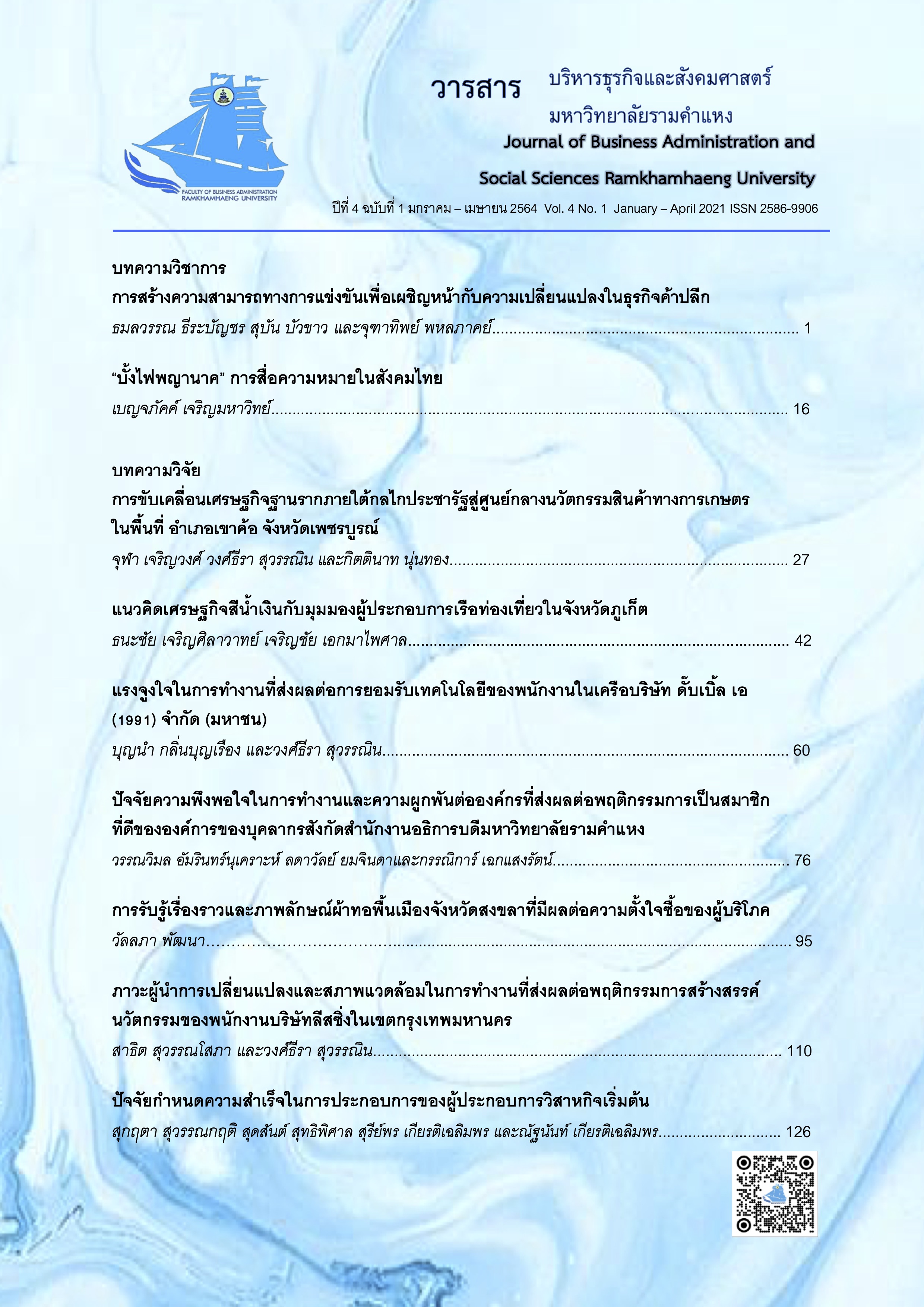Brand Story Perception and Image of Songkhla Local Woven Fabrics Affecting Consumers’ Purchasing Intention
Main Article Content
Abstract
In this study, the researcher examines 1) the level of the purchasing intention for Songkhla local woven fabrics; investigates 2) the brand story perception and image of Songkhla local woven fabrics affecting the purchasing intention for the fabrics under study; and studies 3) the image of Songkhla local woven fabrics affecting the purchasing intention for the fabrics under investigation. The technique of purposive sampling was employed in the collection of data. The research instrument was a questionnaire with 385 consumers who never had any knowledge of Songkhla local woven fabrics and who had never bought the fabrics under study. Data were analyzed using descriptive statistics and the technique of multiple regression analysis.
Findings showed that consumers exhibited the purchasing intention for the fabrics under investigation at a high level. The brand story perception for the fabrics under study affected the purchasing intention for these fabrics. The image of Songkhla local woven fabrics affected the purchasing intention for the fabrics. Therefore, consumers’ purchasing intention for these fabrics was the result of brand story perception and the image of the fabrics under investigation.
Article Details
เนื้อหาและข้อมูลในบทความที่ลงตีพิมพ์ในวารสารบริหารธุรกิจและสังคมศาสตร์ มหาวิทยาลัยรามคำแหง ถือเป็นข้อคิดเห็นและความรับผิดชอบของผู้เขียนบทความโดยตรง ซึ่งกองบรรณาธิการไม่จำเป็นต้องเห็นด้วย หรือร่วมรับผิดชอบใดๆ
บทความ ข้อมูล เนื้อหา รูปภาพ ฯลฯ ที่ได้รับการตีพิมพ์ในวารสารบริหารธุรกิจและสังคมศาสตร์ มหาวิทยาลัยรามคำแหง ถือเป็นลิขสิทธิ์ของวารสารบริหารธุรกิจและสังคมศาสตร์ มหาวิทยาลัยรามคำแหง หากบุคคลหรือหน่วยงานใดต้องการนำบทความทั้งหมดหรือส่วนหนึ่งส่วนใดไปเผยแพร่ต่อ หรือเพื่อกระทำการใดๆ จะต้องได้รับอนุญาตเป็นลายลักษณ์อักษรจากวารสารบริหารธุรกิจและสังคมศาสตร์ มหาวิทยาลัยรามคำแหง ก่อนเท่านั้น
References
จันทร์จิรา นันตีสู้ และอุมาวสี ศรีบุญลือ. (2561). อิทธิพลของส่วนประสมการตลาดและภาพลักษณ์ตราสินค้าที่มีต่อคุณค่าตราสินค้า. RMUTT Global Business and Economics Review, 13(2), 1-15.
ณัชชาภัทร เวียงแสง, รุ่งนภา กิตติลาภ, และสมพงษ์ จุ้ยศิริ. (2559). ปัจจัยที่มีผลต่อการตัดสินใจซื้อผลิตภัณฑ์ผ้าไหมของผู้บริโภคในเขตเทศบาลนครขอนแก่น. ธรรมทรรศน์, 16(3), 133-142.
ธัญญธร ศรีวิเชียร.(2561).กลยุทธ์การตลาดบริการสำหรับธุรกิจร้านผ้าพื้นเมืองในภาคตะวันออกเฉียงเหนือ
วารสารวิชาการแพรวากาฬสินธุ์ มหาวิทยาลัยกาฬสินธุ์, 5(1), 60-74.
ธีรพันธ์ โลห์ทองคำ. (2560). องค์ประกอบสำคัญของกลยุทธ์การสร้างแบรนด์. สืบค้นเมื่อ 17 เมษายน 2561, จาก http://marketeer.co.th/archives/105948
นพพล เจริญสุข. (2557). ผ้าทอภาคใต้: ความหมายและพลวัตของผ้าทอในมิติของเจ้าของวัฒนธรรม. วารสารมนุษย์ศาสตร์สังคมศาสตร์ มหาวิทยาลัยทักษิณ, 9(1), 147-165.
ประสพชัย พสุนนท์. (2556). วิจัยไม่ใช่เรื่องยาก. วารสารศึกษาศาสตร์ มหาวิทยาลัยสงขลานครินทร์ วิทยาเขตปัตตานี, 24(2), 139-149.
พัชรวรรณ ลิ่มรัตนมงคล และไกรชิต สุตะเมือง. (2557). การตัดสินใจซื้อผ้าฝ้ายทอมือของกลุ่มเจนเนอเรชั่น
วายในเขตกรุงเทพมหานคร. วารสารการเงิน การลงทุน การตลาด และการบริหารธุรกิจ, 2(3),
-353.
ภูษณิศา เหล่าดำรงกูล. (2558). อิทธิพลของประเทศต้นกำเนิดสินค้า ความตระหนักรู้ในตราสินค้า ภาพลักษณ์ของตราสินค้าอรรถประโยชน์หรือการใช้งาน การใช้งานเพื่อการปรับตัวทางสังคม และทัศนคติต่อตราสินค้าที่มีต่อความตั้งใจซื้อสินค้าแฟชั่นหรูหราของผู้บริโภคในจังหวัดกรุงเทพมหานคร. การค้นคว้าอิสระ บริหารธุรกิจมหาบัณฑิต, มหาวิทยาลัยกรุงเทพ.
ภาสิริ เตชะวิทยาศิลป์ และสราวุธ อนันตชาติ. (2561). ผลของภาพลักษณ์ประเทศแหล่งกำเนิดสินค้า ประเทศผู้ผลิตสินค้า และความเกี่ยวพันต่อพฤติกรรมผู้บริโภค. วารสารการประชาสัมพันธ์และการโฆษณา, 11(2), 29-58.
อันธิกา ทิพย์จำนงค์. (2557). การพัฒนาตลาดผลิตภัณฑ์ผ้าทอ อำเภอกระแสสินธุ์ จังหวัดสงขลา. วารสารศรีนครินทรวิโรฒวิจัยและพัฒนา (สาขามนุษยศาสตร์และสังคมศาสตร์), 6(12), 161-171.
Biel, A. L. (1997). Discover brand image: The hardness of the softer side of branding. International Journal of Advertising, 16(3), 199-210.
Boulding, K. E. (1975). The Image: Knowledge in Life and Society. MI: University of Michigan Press.
Burton, M., Wang, W. C., & Worsley, A. (2015). Demographic and psychographic associations of consumer intentions to purchase healthier food products. Preventive Medicine Reports, 2, 21-26.
Chi, H., Yeh, H. R., & Tsai, Y. C. (2011). The influences of perceived value on consumer purchase intention: the moderating effect of advertising endorser. Journal of International Management Studies, 6(1), 1-6.
Das, G. (2014). Linkages of retailer personality, perceived quality and purchase intention with retailer loyalty: A study of Indian non-food retailing. Journal of Retailing and Consumer Services, 21(3), 284-292.
Fan, Q. (2019). Relationship among China’s country image, corporate image and brand image : A Korean consumer perspective. Journal of Contemporary Marketing Science, 2(1), 34-49.
Keller, K. L. (2003). Brand synthesis: The multidimensionality of brand knowledge. Journal of Consumer Research, 29(4), 595-600.
Klapper, J. T. (1960). The Effects of Mass Communication. Glencoe, Ill.: Free Press.
Souiden, N., Pons, F., & Mayrand, M. (2011). Marketing high-tech products in emerging markets: The differential impacts of country image and country-of-origin’s image. Journal of Product & Brand Management, 20(5). 356–367.


